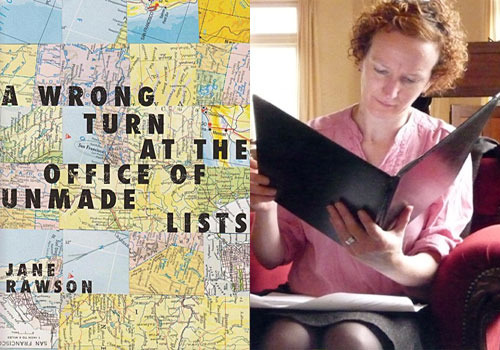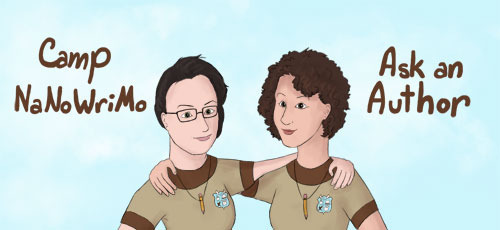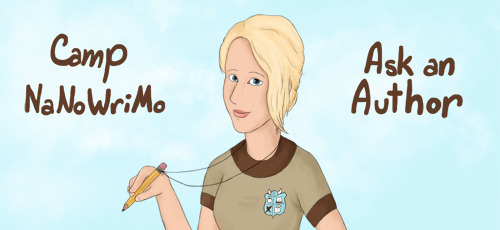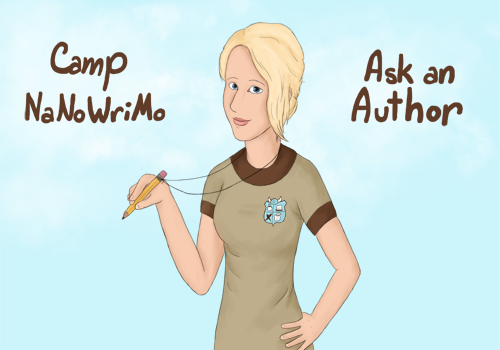Chris Baty's Blog, page 210
July 12, 2013
I Published My NaNoWriMo Novel! Jane Rawson on Busting Writing Blues and Deadly Flora

Australian Jane Rawson took part in her first NaNoWriMo back in 2000, when she was living in Oakland, California. Jane now lives in Footscray, a suburb of Melbourne, and works as an editor at the cool news site The Conversation. One of her NaNoWriMo manuscripts, A Wrong Turn at the Office of Unmade Lists, was just published. NaNoWriMo founder Chris Baty pestered Jane to find out more about the book and her native land.
Right now Camp NaNoWriMo participants are wrapping up the second week of their novels. What would you tell a writer going through Week Two of NaNoWriMo for the first time?
Soon it will be Week 4 and this will be nothing but a horrible memory. And then you’ll realise how much you miss it. You know how old parents tell new parents who haven’t slept for six weeks because their horrible baby keeps screaming that they should enjoy this time because “they grow up so fast"? Well, that. But your screaming baby is your implausible plot and interchangeable characters.
What’s the thing that surprised you most about the process of having your book published?
Getting the email saying that Transit Lounge wanted to publish my book. I really had to read it three times because I was thinking “this is a weird way to write a rejection letter."
So, in one sentence, what is A Wrong Turn at the Office of Unmade Lists about?
How memories and imaginary futures can be more important than so-called real life.
Ooh. I like it. What’s the premise of the story?
Caddy lives in a big western city in 2030. It’s hot all the time, and only the wealthy have reliable water, power, housing and work. Caddy has lost her house and husband in an industrial accident, and is struggling to get by. Her friend Ray gets hold of some maps that let him travel into washed-up memories and imaginings.
He and Caddy mess around with them, and meet up with two kids Caddy made up; she wrote a short story set in 2007 where they were set a task to see all of America, 25’ square by 25’ square. When the kids discover that they and their quest are imaginary, they’re understandably pretty pissed off.
If you were to use the time-honored Hollywood formula of “It’s ____ meets ____" to pitch your book, how would you fill in those blanks?
Technically, it was “big glass of wine meets approaching deadline."
Inspiration-wise, it’s James Gleeson meets travel snobbery. But none of that would fly in a pitch meeting, so let’s say it’s Riddley Walker meets The Golden Compass but with a bit less grimness (have you read Riddley Walker? That thing is grim), more words you can understand, the same amount of drinking, and far fewer armoured bears.
You are known primarily as an environmental journalist. How did your work covering the environment there in Melbourne, Australia seep into your novel?
It seems logical that my work on climate change would have informed my novel set in a climate-changed Melbourne but I wrote the book before I had this job. Let’s say that my obsession with catastrophe has influenced both my writing and the work I choose to do.
You were one of the 140 people who took part in NaNoWriMo in 2000, and you attended the first-ever Thank God It’s Over party. What are your favorite memories of those prehistoric days?
At the TGIO party, everyone had a section of their story strung up on a washing line so other people could read it. Actually, that might be all I remember. There was dancing! I remember there was some excellent dancing. Other than that, all I can say is that it was way cooler back then that it is now. (Actually, that’s a total lie. I couldn’t be more pleased that NaNo has grown to be a massive success. It’s heartily deserved.)
Have you started on your next book? What’s it about? And is it also a NaNoWriMo novel?
I have. I wrote the first 50,000 words of my ‘current’ novel in NaNo 2011. It’s pretty much the opposite of Unmade Lists. It’s set in Port Adelaide, Australia, in the late 19th century and is based on the life of my great, great grandfather, who was stuck on a shipwreck for 8 days without food or water. He was one of a small handful of survivors. I wanted to explore what it would be like living with post traumatic stress disorder before it had even been invented.
Is it true that every plant in Australia can be fashioned into a weapon?
I just tried to research this, and I cut myself.
[Interviewer’s note: Right after sending me her answers, Jane went on a trip to Tasmania, where she was jabbed by a plant that ended up causing her finger to become infected. She blames the interviewer for this.]
July 11, 2013
Ask a Published Author: How do you keep each character's voice fresh?

Julia Crouch (left) began her working life as a theater director and playwright. Her second NaNo-novel Cuckoo landed her a three-book deal. She spends her days writing at an untidy desk in a shed at the bottom of her garden in Brighton, with occasional changes of scene.
How do you make each character sound fresh, new, and realistic while making sure they’re not in the same “voice"? — Anonymous
Because I work on each book for so long, I get to know my characters very well. Sometimes, the character develops as I write so at the end, when I know the character better, I will go back and rewrite that character using my discoveries. Other times, the character is the first thing that comes to me. The characters Polly and Rose, for example, were the starting point for Cuckoo, as was Peg in Tarnished.
In either case, I will make up a sheet for each character with a physical description and biography (I use Scrivener, so this is easy). I add to the sheet as I write, and when I’m editing, I append all physical descriptions to the file as well, so I don’t find myself changing eye colour or hairstyle—easily done between drafts.
The other thing that has helped me with writing characters is my background in theatre and particularly actor improvisation. I worked once with a director called Mike Bradwell and we developed our characters through writing really detailed biographies, going out into town in character, buying clothes that our characters would wear.
Nowadays, I will walk around looking through my characters’ eyes, inhabiting them, if you like. How differently would they view those dogs running around the park? How scared would they be on this street at night? It’s the same when I write—I will often speak out loud in character to get the voice right. Which is why I don’t work in coffee shops very often…
Finally, I always cast characters, and put a photograph on the character sheet. For example, in Cuckoo, Kate Winslet is Rose and PJ Harvey is Polly. In Every Vow You Break, Christopher Eccleston is Stephen and Timothy Busfield (when he was in Thirtysomething) is Marcus. My current cast for my fourth novel Wrecked, which I am in the final stages of editing, includes a young Juliette Lewis and Mia Farrow circa Rosemary’s Baby. I find having a clear visual image really helps to play the scenes in my mind.
Next week’s head counselor will be Ari Marmell, fantasy author of the Widdershins novels and campaign writer for role-playing games including Dungeons and Dragons.
July 10, 2013
Ask a Published Author: How do you find the right words for a passage?

Sarah Duncan (right) has written five novels, the most recent being Kissing Mr. Wrong (shortlisted for the RNA Novel of the Year 2011). She has also taught creative writing at the Universities of Oxford and Bristol.
What do you do when you know what you want to happen in a certain passage of you novel but you just don’t seem to be able to put that into words? Any tips? — Anonymous
If you ever get stuck with a scene, leave it and jump somewhere else. You don’t get extra points for writing in a particular order. Make a few notes on what you want to happen, and then move on. Usually, it’s not coming together because you don’t actually know enough about the characters/story to write it—when you’ve done more writing it’ll be easier. Sometimes it turns out that that scene/passage isn’t really important after all and can be left out.
If you’ve done all that, gone ahead, and now realize that you have to include that scene, then I’d say give yourself permission to write really badly. And I mean really badly. Then have a go at writing something: anything. It can be notes, if that’s how it pitches up on the page. But get something down. Later, you can make it better, but if there aren’t words on the page, you can’t do anything with it. Accept that it will never be as brilliant as the stuff in your head. That’s writing for you.
Finally, if all else fails, ask yourself two questions:
What can my character see and hear right at this moment?
What do they think about what they can see and hear?
Then write that, and see where it takes you.
Next week’s head counselor will be Ari Marmell, fantasy author of the Widdershins novels and campaign writer for role-playing games including Dungeons and Dragons.
July 9, 2013
Ask a Published Author: The Perks of Writing Spontaneously

Julia Crouch’s second NaNo-novel Cuckoo landed her a three-book deal. She spends her days writing at an untidy desk in a shed at the bottom of her garden in Brighton, with occasional changes of scene.
Sarah Duncan (right) has written five novels, the most recent being Kissing Mr. Wrong (shortlisted for the RNA Novel of the Year 2011). She has also taught creative writing at the Universities of Oxford and Bristol.
Do you find planning or pantsing (writing by the seat of your pants) more effective when it comes to writing? — Anonymous
Julia: Definitely pantsing. I planned Wrecked, the novel I am currently working on, and, while I have a lot less story editing to do now that I have finished draft zero (the draft no one but me sees), I really, really missed the spirit of discovery of the pantsing approach.
What do you do when something makes its way into the story completely by accident and then changes the entire novel? —ErinKenobi2893
Sarah: Shout yippee and hallelujah, then run with it. I don’t plan much beyond a few key plot turns, so something pitching up out of the blue is what I hope for! In my opinion, this is the best bit about writing a novel, and shows you have a fully functioning subconscious imagination. The only time I’ve plotted in full, I was bored to tears with the story when I came to write it so tootled off and wrote something completely different.
Next week’s head counselor will be Ari Marmell, fantasy author of the Widdershins novels and campaign writer for role-playing games including Dungeons and Dragons.
July 8, 2013
"It’s very hard to tell, at the end of your writing day, whether you’ve done great work or bad work...."
The good days are when you perform; the slow days are when you learn to perform better. The only bad days as a writer are the ones when you are too cowardly or too lazy to sit down at the keyboard and give it everything you have.”
- Chris Cleave, on why perseverance matters.
July 5, 2013
Ask a Published Author: What needs to be in a first chapter?

Jennifer Bosworth was born in Price, Utah. As a kid, her favorite thing to do was roam through the hills and tell herself stories. As an adult, she does the same thing, only now she’s roaming the streets of Los Angeles, her favorite city in the world. Struck is Jennifer’s first published novel.
I’m starting my novel today (Yay!!) But I have been avoiding the first chapter because it is a little intimidating. What are the essentials that need to be in a first chapter and how do you go about when you write them? — Ceileidh
I adore writing first chapters. That being said, the first chapter I write rarely ends up being the first chapter in the final draft.
In the case of my novel Struck, the first chapter ended up as the 22nd chapter. More often, writers tend to start their books too early, and that’s completely okay. I believe this tendency stems from the need to spend time getting to know your character before you plunge them too deep into the meat of the story. Yet another common tendency is to begin your story with a character waking up. This is actually how The Hunger Games commences, and it can work, but it’s still considered a rookie mistake by many.
But enough about what not to do. Let’s talk about what to do with a first chapter.
There is no one, perfect way to start a book, just as there is no one way that all writers should craft their stories. But there are a few methods for approaching first chapters that will help you capture the reader’s attention and leave them wanting more:
Forget first chapters, the first line is even more important! This is some valuable real estate, people. In a single line you can convey voice or irony. Tragedy or mystery. Humor or horror. For me, the best first lines contain some kind of hook, an element that sets the book apart.
The first line of Struck reads:
“When you’ve been struck by lightning as many times as I have, you start to expect the worst pretty much all the time."
This line was specifically crafted to do several things. It gives a sense of the character’s voice, and conveys her innate pessimism. And it tells the reader that she is extraordinary. Only a special kind of person can survive countless lightning strikes.
What do you want your reader to know upon reading your first line? How do you want them to feel? What is it about your story that’s going to grab their attention?
Here are a few examples of wonderful first lines:
Joe Hill, NOS4A2:
"Nurse Thornton dropped into the long-term-care ward a little before eight with a hot bag of blood for Charlie Manx."
Marie Lu, Legend:
"My mother thinks I’m dead."
Kristin Kittscher, The Wig in the Window
"I thought I’d mastered the art of escape."
Lead with your strengths. Are you a master of dialogue? Then start with a conversation. Do you have voice nailed down? Then go with a voice-filled first chapter that makes us fall in love with your protagonist. Are you writing something comedic? Then start with something that will make the reader chuckle. Does your story have a great hook? Maybe we need a taste of that hook in the first chapter. Are you writing a horror novel? If so, you don’t have to scare us right away, but you do have to create a tone that will carry through the rest of the novel.
Don’t get attached. Honestly, the most important thing is to start. Maybe you don’t have the perfect first chapter figured out yet. Who cares? It took me several rewrites before I found my first chapter for Struck. If you don’t start, you’ll never finish. So just write something. Don’t think too much. You can always go back and revise until you get it just right, but before you can hone your first chapter, you have to write your last chapter.
Many writers get so caught up in perfecting their opening that they never finish a book. Don’t let yourself become a statistic. It’s more important to have a completed draft than to have nothing but a perfect first chapter.
Next week, UK authors Julia Crouch and Sarah Duncan will team up as Head Counselors. Julia is the author of thrillers Cuckoo and Tarnished . Sarah has written five romance novels, including Kissing Mr. Wrong .
July 3, 2013
Ask a Published Author: "How do you write a satisfying ending?"

Jennifer Bosworth was born in Price, Utah. As a kid, her favorite thing to do was roam through the hills and tell herself stories. As an adult, she does the same thing, only now she’s roaming the streets of Los Angeles, her favorite city in the world. Struck is Jennifer’s first published novel.
How do you write a satisfying ending? - readwritedrawflight
I love this question. I love it because of the word “satisfied." Anyone can write an ending, but writing a satisfying ending takes a lot more effort to craft. But I do have to say, when writing a first draft, the most important thing is to get to the end, whether it’s a satisfying end or not.
Once you finish your draft and let it sit for at least a couple of weeks to get perspective, it’s time to start the refinement stage. If you’ve written an ending you love, you have to go back through the manuscript and make sure you’ve set that ending up. For me, a satisfying ending is one that is simultaneously unexpected and inevitable. When I think about satisfying endings, two come immediately to mind: the ending of the film, The Ring, and the ending of Gillian Flynn’s best-selling mystery, Gone Girl. The ending of “The Ring" is perfect. Everything in that story comes full circle: theme, characters, plot. It is a flawlessly crafted ending.
The ending of “Gone Girl" is not as widely accepted as a satisfying ending, but that’s an emotional response, not a logical one. Everything that happens in the novel leads to a certain resolve. If the resolve were different, the rest of this genius novel would have to be different. We would have an entirely different book.
In regards to satisfying endings, remember to ask yourself these questions before you begin to revise:
Have I set up the ending of this story, or does it come out of nowhere? Have I been too obvious about my set-up, making the ending predictable?
Have my main characters arced? Have they completed a transformative journey?
Does my ending support the theme of the book?
Next week, UK authors Julia Crouch and Sarah Duncan will team up as Head Counselors. Julia is the author of thrillers Cuckoo and Tarnished . Sarah has written five romance novels, including Kissing Mr. Wrong .
July 2, 2013
Ask a Published Author: "How do you meld genres?"

Jennifer Bosworth was born in Price, Utah. As a kid, her favorite thing to do was roam through the hills and tell herself stories. As an adult, she does the same thing, only now she’s roaming the streets of Los Angeles, her favorite city in the world. Struck is Jennifer’s first published novel.
How do you meld two or three genres? Does one genre become more dominant over the other? — abeille.yew
With cross-genre novels gaining appeal, they’re becoming an easier sell but they’re still a tricky bag to write. The mistake many writers make when crafting a cross-genre novel is that they do often fail to identify the dominant genre. They try to represent each genre equally.
But … there should be a focus genre. Just because a romance novel contains elements of suspense, mystery, and the supernatural, does not mean the story relies equally on each of those genres. My debut novel, Struck, combines elements of a post-apocalyptic story, a supernatural story, action/adventure, and romance. But above all, I refer to Struck as a post-apocalyptic adventure with a supernatural twist. (I don’t even mention the romantic element because it’s a given. Practically every YA novel these days has at least a glimmer.)
If you’re having a difficult time deciding which genre should be your dominant one, ask yourself which one you could most easily strip from your novel idea. If you’re starting a romantic sci-fi thriller, could the idea stand on its own without the thriller element, or the romantic element, or the sci-fi element? The genre left standing is your focus genre.
One more thing to keep in mind is the classic combo factor. Some genres combine with the fated perfection of chocolate and peanut butter. Historical romance. Sci-fi thriller. Romantic comedy. Urban fantasy. These genres have been around for a while and aren’t going anywhere. Your story might be one of these, and if it is, run with it.
Next week, UK authors Julia Crouch and Sarah Duncan will team up as Head Counselors. Julia is the author of thrillers Cuckoo and Tarnished . Sarah has written five romance novels, including Kissing Mr. Wrong .
July 1, 2013
"Besides, there are already plenty of novels. There is no need for a new one. One could devote one’s..."
In fact, think of the world of literature as an enormous meal, and your novel as some small piddling ingredient—the drawn butter, for example, served next to a large, boiled lobster. Who wants that? If it were brought to the table, surely most people would ask that it be removed post-haste.”
-
Lemony Snicket, on why writing your novel (yes, yours) matters.
Happy Camp NaNoWriMo, writers, individuals, uniquely-gifted chefs.
June 29, 2013
Ask a Published Author: "How do you avoid over-description?"

Oh! Steampunk! That’s my genre! Being the imaginative genre that it is, how do you get your vision across to the readers without overdoing descriptions, or improperly using description in the first place? — Dream3r
When it comes to descriptions, I try to describe things through the eyes of the character. To give you an example, in Innocent Darkness, my main character Noli likes to fix and invent things. If she saw an airship, she might wonder educatedly about how it worked, and would pay attention to the details that interest her. However, Steven, one of the other POV characters, probably wouldn’t care and might give it only a cursory description.
It’s the same with clothes. Noli’s mother is a dressmaker, so she might spend a sentence or two on what someone was wearing. In contrast, Steven, as a teenage boy, might note that someone’s dress was green, if he bothered to notice it at all. I find that using this as a guideline helps me to make sure I don’t over-describe in a way that is out of character, which can pull readers out of the story.
Also, less is often more—you don’t need to constantly remind the reader that this is a steampunk story, which is easy to do. Also, ask yourself, “Does the reader need to know this?" and, “Does the reader need to know this right now?"
Suzanne Lazear is the author of the steampunk fairytale series The Aether Chronicles. Innocent Darkness is out now. The sequel, Charmed Vengeance , will be released on August 8, by Flux.
Next week Jennifer Bosworth, author of the YA novel Struck, will take up the Head Counselor whistle and answer your questions! Ask her about first-week jitters, writing YA, and more here!
Chris Baty's Blog
- Chris Baty's profile
- 63 followers



